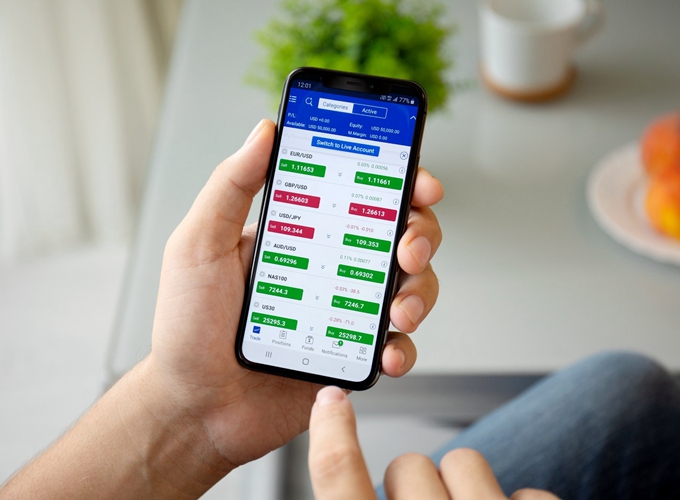Crypto Leverage And Margin Trading: Beginner's Guide
The massive 2021 crypto bull run saw the price of Bitcoin jump from $30000 in January, to an all-time high of $69000 In June. However, the price is currently trading at $22000. The huge volatility caused a buzz and attracted much attention, boosting mainstream interest in digital tokens. People scoured all over the web looking for ways to profit from the fast and deep price swings.
Margin trading enables individuals to go long or short on a cryptocurrency with leverage quickly and easily, even during a crypto bear market. Its main advantage is using less capital (margin) to leverage trade crypto in order to acquire a higher potential return in the short-term timeframe. However, leverage is a double-edged sword, you should fully understand leveraging crypto and the risks.
Bitcoin price chart today from Mitrade▼
What Is Leverage & Margin Trading?
Leverage refers to trading with borrowed funds to increase the position's size. Leverage trading allows users to borrow money from exchanges and brokers so that they can use a small amount of capital (margin) to get bigger market exposure.
The use of leverage is very common in the cryptocurrency world, and many trades have leverage. The common types of leverage products include bitcoin futures, bitcoin CFDs, bitcoin options. You can trade spot crypto with leverage on Binance, there are also Contracts type that enables individuals to track the crypto price fluctuations and trade without owning the spots.
Leverage is usually expressed as a ratio. If you are trading bitcoin with a broker that offers 50:1 leverage, you can hypothetically use $200 to trade $10,000 worth of bitcoin. The initial capital of $200 is called the margin.

In fact, leveraged trading in the cryptocurrency market is essentially the same as leveraged in the forex and stock markets. They are all derivatives, commonly used in short-cycle trades.
How Does Crypto Leverage Trading Work?
First, you will need to deposit initial capital into your trading account. Leverage and margin go hand in hand. Margin is the actual amount required to open a leveraged position. Think of margin as a good faith deposit or collateral and leverage as the multiplier.
Crypto leverage is usually calculated in fixed amounts which vary between brokers. Brokers leverage traders as per their rules and regulations. Leverage amounts are usually given as ratios, typically 2:1, 5:1, 10:1, 50:1, 100:1, and 125:1. Let's assume the broker requires a 2% margin to open a trade. In simple words, you need to put up 2% of the trade size to open the position.
In addition to margin deposits, you need to be aware of the broker's margin threshold, also known as maintenance margin, which is designed to keep your positions from being liquidated. If the margin falls below the maintenance threshold with price fluctuations, you will have to deposit extra funds into your account.
Leverage Short and long trading
Leveraged trading is used to go long and go short. When trading with leverage, you can speculate product price movements which then inform your decision to either buy or sell. If you buy an asset because you believe the price would rise, this is termed 'going long' and when you sell it is called 'going short'.
The basis of long trade is to“Buy Low = Sell High”
However, a short trade is to “Sell High = Buy Low”
Example of Bitcoin Trading With Leverage
It is imperative that you consider the risk involved before opening leveraged positions. You don’t have to bet your entire account on trade even when a broker offers more than 50:1 leverage. You can reduce leverage on specific positions simply by reducing the position size. Here is an example:
Jack and Jill both have $10,000 trading accounts with a broker that offers up to 50:1 leverage for bitcoin trading.
Jack chooses to go all-in with a BTC sell position by taking the full 50:1 leverage (50 x $10,000 or 50 lots). This means selling $500,000 worth of Bitcoin. Let's assume the value of bitcoin was at 8170 at the time of the trade entry. If it falls by $100 to $8070, Jack will lose $5,000 or 50% of the capital in his trading account.
Jill, on the other hand, is wary about high leverage and trades with minimal risk only using 5:1 leverage (5 x $10,000 or half a standard lot which is 0.5 lots). After losing the trade, Jill would have lost only $500 or 5% of his trading account.
So while Jill has 95% of her capital intact, more than enough to open other positions. Meanwhile, Jack is down by 50% and will need to raise a massive 100% of the remaining capital to break even. Jill, however, will break even once a winning trade returns 5.5%.
The Advantages and Disadvantages of Crypto Leverage
What are the advantages of Leverage Trading?
Leverage allows you go long and go short
By using leveraged products, you can profit from both rising and falling markets, that is the ability known as shorting.
Leverage allows you to control larger positions
For example, a 1:100 leverage means that for every $1 in your trading account, you can control $100. So if you have $1,000 in your account, you can potentially buy or sell $100,000 worth of any tradable instruments. The broker hypothetically lends you the rest of the money. Without leverage, you have to raise the whole $100,000.
Leverage magnifies your potential profits.
Here is an example. A deposit of $1000 enables you to open a $100,000 position (1:100 leverage). If your position makes 1% profit, you gain $1000 or a massive 100%. Without leverage, a 10% gain on your $1000 investment equates to $10.
What are the disadvantages of Leverage Trading?
Magnified Losses
Using leverage can lead to higher risk because both the profits and losses will be magnified.
The problem of margin call
You're required to keep a certain amount of cash in your account. Once your margin account runs low on required funds, you will get a margin call for additional capital, or the position will be closed and you lose money.
How To Handle Leverage Risks?
With our illustration above, you can see how leverage can hurt your trading account when it goes against you. So what should you do?
1. Don't bet the farm
In our example, Jack risked half his capital on one position. This is wrong. Every trade can turn to a loss regardless of the success rate of your trading strategy. Bitcoin trading is riskier due to the high volatility. Therefore, you should risk 3% at most of your account balance. Risk management helps you withstand several losing positions if trades head south. Additionally, huge losses can trigger fear and other emotional behaviors. They increase the chances of losing the remaining capital, making it hard to break even.
2. Use Stop loss
Stop-loss is a price level where a losing position closes automatically. Setting fixed stop-loss lets you know the amount you risk losing if the trade fails. The position of your stop-loss depends on your trading strategy. Ideally, you should set stops at a point where the trading position becomes invalidated.
Unfortunately, standard stops are not always honored. Trades close at the best available price depending on stop level. During extreme volatility, the best available price might be pips away from your actual stop loss. This is yet another reason why you should risk small amounts per trade. If you risk 1% and the price overshoots your stop by 2%, your loss would only increase from 1% to 3%. However, if you risk 10%, you risk making a 30% loss.
3. Consider Guaranteed Stops
Guaranteed stops function like conventional stops with an added twist. The broker will close your position at the designated stop loss regardless of what happens in the market. This means high volatility or weekend gaps will not affect your positions.
What is the Best Leverage Ratio for a Beginner?
Depending on the broker of choice, you can get anything from 1:2 to 1:100 leverage. However, as a beginner, you should not get swayed by these figures. Low-leverage brokers help you avoid excessive risk. For bitcoin leverage trading, do not use more than 1:5 leverage. You can go as high as 1:10 for other less volatile instruments.
Remember, it is not compulsory to use the full leverage advertised by the broker. By varying your trade sizes appropriately you can still trade with 1:5 leverage even if the broker offers 1:100 leverage.
Start Crypto Leverage Trading With Mitrade
There are many forex brokers today offering bitcoin and other cryptocurrency CFDs. Mitrade is one of the best platforms today for bitcoin leverage trading in CFDs. The broker perfectly understands the importance of protecting traders from Bitcoin volatility by limiting the leverage on the crypto to 1:2. Mitrade offers a maximum of 1:30 leverage for standard forex currency pairs.
To start crypto leverage trading on Mitrade, follow these 4 steps:
◆ Go to Mitrade platform
◆ Search the markets you want to trade and select it
◆ Open a Long or Short position
◆ Set up your position size and Confirm the trade
The Bottom Line
Cryptocurrency leverage trading can be highly rewarding if you understand leverage and margin. The crypto's volatility increases the chances of making more profits than you would get by trading currency pairs. However, volatility is a double-edged sword, especially when combined with high leverage. Bitcoin traders should, therefore, keep a lid on their risk at all times.
You May Also Like
Buying Bitcoin with a Credit Card or Debit Card
10 Ways You Can Do To Make Money with Cryptocurrency
Top 10 Best Cryptocurrencies Worth Investing
* The content presented above, whether from a third party or not, is considered as general advice only. This article should not be construed as containing investment advice, investment recommendations, an offer of or solicitation for any transactions in financial instruments.
- Original
- Trading Analysis

Risk Warning: Trading may result in the loss of your entire capital. Trading OTC derivatives may not be suitable for everyone. Please consider our legal disclosure documents before using our services and ensure that you understand the risks involved. You do not own or have any interest in the underlying assets.






